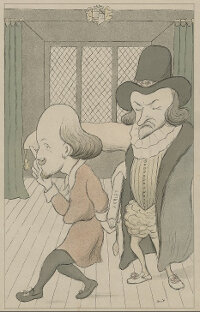Frank Harris
London: Frank Palmer, 1910
Written, Harris says, in 1904, this play covers the same ground as Shaw’s “The Dark Lady,” though less successfully. Harris was incensed when Shaw’s play appeared in 1910, and rushed this one into print claiming in the preface: “I have not yet read or seen Mr. Shaw’s play: I only wish here to draw attention to the fact that he has already annexed a good deal of my work and put it forth as his own, […] I naturally infer that in this play he has taken from me even more than he could hope to pass off as his own.” In the play, Shakespeare desperately admires the Dark Lady, Mary Fitton (1578-1647), and asks William Herbert, Earl of Pembroke (1580-1630) to play Cyrano for him. Fritton falls for Herbert (an historic fact), and the emotional turmoil inspires Shakespeare’s most productive writing before he retires to a melancholy life in Stratford. —VH
Read more about the play
Read the full text









